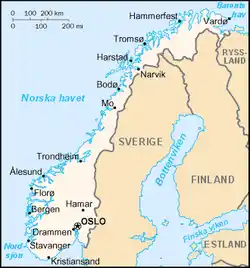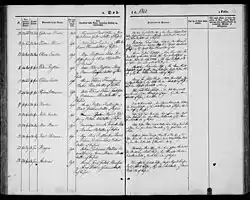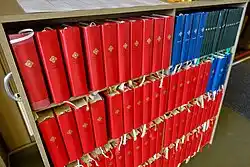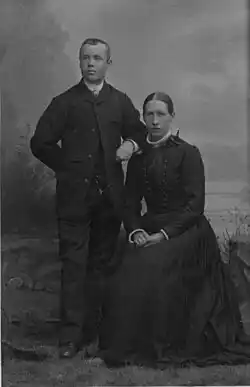If you're interested in tracing your Norwegian ancestry, Norway research with online records can be a great place to start.
Norway is a small country with a rich cultural heritage, and many people are eager to discover their Norwegian roots.
In this article, we will provide you with a comprehensive overview of Norway research with online records, including church books, census records, and other historical records.
Research your ancestors on MyHeritage
Geography and immigrationGeography and immigration

Norway is a relatively small country, with a population of about five million people. The country's small population is due to its limited agricultural land, which is only 3.4% of Norway's total landmass.
County boundaries and names have changed over time in Norway. A good resource for understanding the older county names and newer county names is the Norway Maps article on the FamilySearch Wiki. The wiki article also has a useful set of maps for each county that shows the various parishes in the county.
The country has a rich history of immigration, with Norwegians settling in Minnesota, Wisconsin, the Dakotas, and Western Canada in the United States.
Norway ranks second globally for the country that experienced a larger percent of its population immigrating to the United States, with only Ireland beating Norway in that metric.
PatronymicsPatronymics
Patronymics is an important aspect of Norwegian family history. It is the practice of naming a child after their father or grandfather. Norwegian and Danish are similar in how they spell the words for son and daughter, which has an influence on their patronymics. Thus, when looking at Norwegian patronymic names, it is common to see endings like S-E-N or the endings D-A-T-T-E-R. However, during a hundred-year period in the 1800s to the early 1900s, Denmark was on the losing side of one of the Napoleonic wars, and the King of Denmark was forced to cede Norway to Sweden. During this period, Norway was part of Sweden as the United Kingdom of Sweden and Norway. In certain parts of Norwegian society, it became fashionable to use a Swedish spelling for patronymics, resulting in spellings like S-O-N or D-O-T-T-E-R.
Norway recordsNorway records

The church books and census records are the top-tier records for Norway genealogy research.
Norway, however, has a significant number of different geological records that we won't cover in detail.
In this section, we will look at the Norway census, death registrations from the early 1900s, Bygdeboks, and address books.
Census recordsCensus records
Norwegian census records are a key resource for genealogists looking to trace their Norwegian ancestors. The country's census coverage is quite robust, with records dating back to 1801, although there are gaps in the data that researchers should be aware of. The 1801 census is a full-name census, meaning that every individual in the household, regardless of gender or age, is listed by name. This is in contrast to earlier US censuses, which only listed the heads of households.
After 1801, there is a significant gap in the data until the 1865 census. The 1815-1855 censuses collected only statistics, with no names of individuals listed. Censuses from 1865 onwards do include individual names, although the 1930-1960 censuses are currently protected by privacy rules.
It's worth noting that some of the censuses only cover limited geographical areas, such as trading centers, ports, and larger cities. If your ancestors lived in one of these areas, these censuses can be very helpful.
The National Archives of Norway and MyHeritage are two of the primary online sources for Norway's census records. The National Archives currently has a robust index for the 1910 census, with images recently made available. The 1920 census has also been released by the National Archives, with indexing ongoing. MyHeritage has a collection of census records dating back to 1801, with newly linked images.
Church recordsChurch records

Norwegian church records are another important source of genealogical information. These records, also known as church books or parish registers, were collected by Lutheran ministers and cover births and baptisms from 1815 through 1919, marriages from 1815 through 1937, and deaths and burials from 1815 through 1938.
It's important to note that names of all persons listed on a death or burial after 1934 have been redacted. Nevertheless, these records can still provide a wealth of information for genealogical research, including dates of birth, death, and marriage, as well as names of parents and spouses.
MyHeritage is a great source for Norwegian church records. Its collection includes records from 1,200 parishes, covering 12 million individuals. Researchers can search by name, location, and other parameters, with images available for many records.
Norway emigration registersNorway emigration registers

One of the most comprehensive online records for tracing Norwegian ancestors is the Norway Emigration Register.
This collection, which was released in June of 2022, contains information on people who left Norway for various parts of the world, including the US and Canada, from as early as 1867. This register has a robust search field that allows you to search for your ancestors by name and destination.
You can also find information on their birth year, estimated from their age, and the place they left from.
The police were involved in these immigration registers to help immigrants purchase tickets and avoid being swindled by unscrupulous companies.
If your ancestor left Norway before 1867, the odds of finding an outbound immigration record are quite low. However, this collection can help you locate records of their migration.
Norway death registrationsNorway death registrations
Another significant online record for Norway research is the Norway Death Registrations. This collection, which covers the period between 1927 and 1941, provides a full death date, information on marital status, and a full birth date of the deceased. Although some of the records have redactions to comply with Norwegian privacy laws, they are still very helpful. The collection is especially useful if you are looking for persons who died before 1941, soon to be before 1961, as you can often find them and then use census or church records to trace their lives further.
National archives of NorwayNational archives of Norway
The National Archives of Norway website is an essential resource for tracing your Norwegian ancestry. The website has a vast collection of digitized materials, including images and metadata. You can search for materials using their collection catalog or browse the scan archives. The website is available in English, but it is recommended that you use the Google translate feature to translate the content from Norwegian to English. Some of the content at the National Archives is image-only, so you will be searching metadata.
One of the most popular collections in the National Archives of Norway is the Digital Archives. The Digital Archives is a vast collection of digitized primary source materials that includes parish registers, census records, probate records, and emigration records. The website has a powerful search engine that allows researchers to search by name, location, and other parameters.
Another important collection in the National Archives of Norway is the Probate Records. The Probate Records are a collection of wills and probate documents that date back to the 1500s. The collection provides a wealth of information about Norwegian families, including their wealth, property, and personal possessions.
The landscape of archives in NorwayThe landscape of archives in Norway
in popular terms, governance is threefold. State, County, and municipalities. The Norwegian archival law demands records kept by every one and each level. The National Archives ("Arkivverket") keeps outdated records from the State government ("Staten") and branches ("Departement"). Some counties and municipalities keep records by themselves. However many have created repertories that can join forces and create organizations named in Norwegian as "Interkommunale arkiv", IKA for short. They often refer to themselves as KAI which is short for "Kommunale Arkiv Institusjoner". Generally a repositories not cooperating with others is a KAI, but all IKA are KAI's. Arkivverket and KAI's run a portal called "Arkivportalen" where they try to keep all records of all levels up to date. Some Museums and other historical societies also show their archives in this portal. Pro tip for users: if you find interesting records other than the area you are researching, ask the local KAI, City archives or the County if they also have these records and where they may be viewed.
The National Library of NorwayThe National Library of Norway
The National Library of Norway is another useful resource for researching your Norwegian ancestry. The library has a collection of interesting materials, including photographs of prisoners and address books for different parts of Norway. The address books were published regularly and contain a lot of names of individuals with their addresses. Although the website is only available in Norwegian, you can use the Google translate feature to translate the content into English.
BygdeboksBygdeboks
The National Archives of Norway has the best collection of Bygdeboks, which are rural history books or farm books. Many of them have been digitized and are available for browsing. Although they vary in format, they generally contain information about families, how they are related to each other, and references. If you can't access some of these records due to restrictions, you can find a friend in Norway or use an IP address that appears to be coming from Norway.
Explore more about Norwegian genealogyExplore more about Norwegian genealogy
- How to Research Your Ethnicity with Genealogy on the MyHeritage Genealogy Hub
- Norway Research with Online Records at MyHeritage and Beyond at Legacy Family Tree Webinars
- How to trace your ancestors in Norway at The National Archives of Norway
- PDF instructions on how to find Online Bygdeboks at the National Library in Oslo
- Norway Church Records, 1815-1938 at MyHeritage
- Norway - Census & Voter Lists records collection at MyHeritage
- Norway, Emigration Registers, 1867-1959 records collection at MyHeritage
- Norway - Birth, Marriage & Death records collection at MyHeritage
- The National Library of Norway

